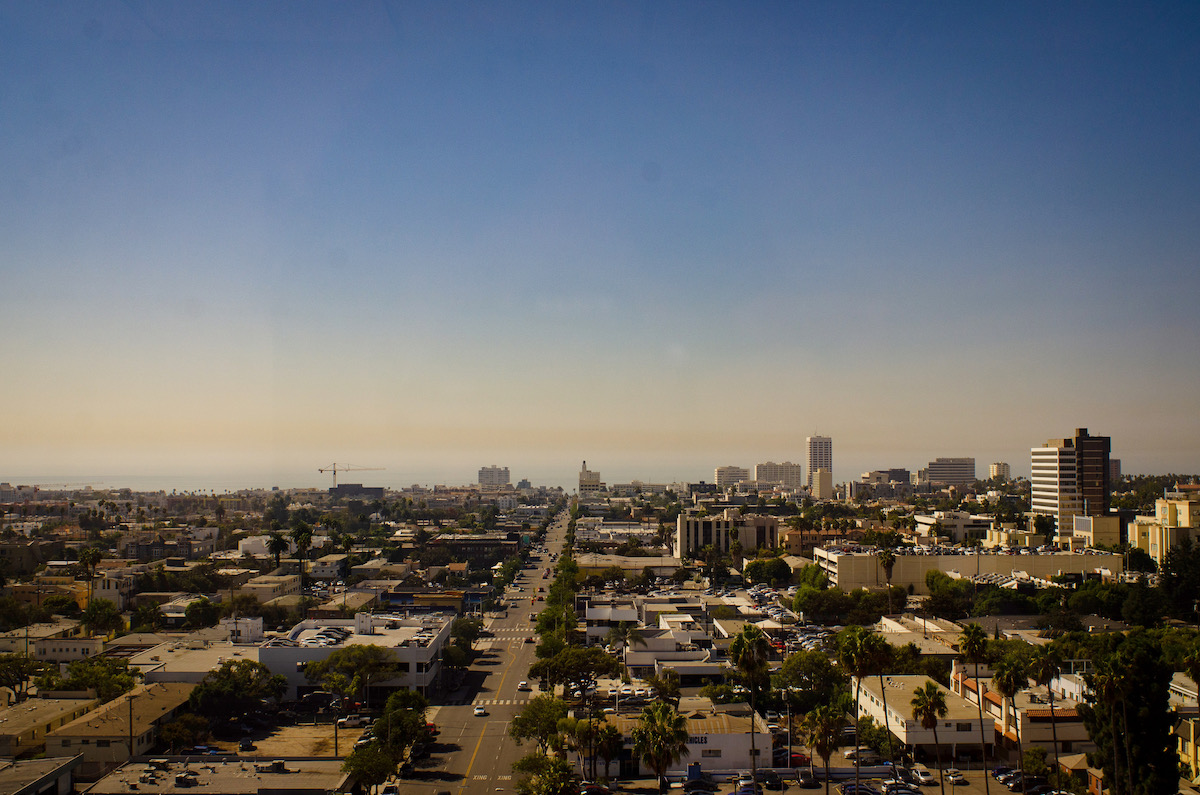
Maybe fallen, but slipping for sure from being a desirable beachfront community that served all equally, the local residents who lived here, the small businesses, and the tourists that came from all around the world to enjoy the wide beaches, Pier, Promenade, and blue skies and gentle breezes. Santa Monica, which plays an even bigger role within the greater Los Angeles region by providing an opportunity for those living in the hottest areas of the Valley, the East Side, and downtown L.A., to escape the oppressive heat of summer, and now, with global warming, even the fall months.
As a low-rise beachfront town, we provided that necessary relief. With relatively easy and direct access to all, we provided, you might say, the lungs for easy breathing to those sweltering under what amounts to living in and under ‘heat sinks’ caused by the high-rise density of downtown L.A., or the the air-choked valleys, and the east side communities. Santa Monica serves a much greater purpose than simply being a livable community for its permanent residents. With its beach and ocean, it is a relief valve for all. The best park ever.
With a few exceptions, Santa Monica was a low-rise beach town, typically not exceeding 3 and 4 stories, providing lots of visible blue sky, and minimally impacting the. ocean breezes that flow into the greater WLA area. A win for all, so to speak. So what happened to cause Santa Monica to fall, to begin to obstruct the blue sky views, to put the sidewalks and pedestrians in shadow, to stem the flow of the cool ocean breezes, to lower the quality of living, and diminish the ability it had in providing relief to so many.
No doubt a complex question requiring an even greater complex answer, but, at the local level, it seems that growing from a well-intentioned effort to help many long-time residents that were well invested in the community, but not economically in a position to invest in ownership of their homes and apartments, and ‘trailer parks’ (let’s not forget The Village Trailer Park development fiasco – boondoggle), rent control was, not so quietly, implemented in the late 1970s. SMRR (Santa Monica for Renters Rights) was formed to help assure equitable affordable housing opportunities. A good thing, and it shook up the city, including its political structure, while implementing new rent control regulations, even to the point of having two construction moratoriums effectively stopping larger new construction for more than a year while the laws were being re-written. Something we could use today!
As time went by, the original group gained council seats, and as new faces emerged within the SMRR organization furthering their hold on the council as the majority political structure in town, changes began to occur within the city structure. Ideologically driven council and planning staff began to re-write zoning and planning goals, opening doors for more and more development, greater heights, and greater density. As with any power structure, losing sight of the original objective and mandate can occur with the increase in power and can become lost along the way for a myriad of reasons, one such being “we know better”, and, without reasonable community-wide consensus, subtlety moving the desired goals, potentially resulting in unintended consequences. And those, all too often end up negative.
During the lead-up to the 2010 revisions and acceptance of the LUCE (Land Use Circulation Element) of the mandated General Plan, there were indeed community workshops with residents participating in crafting a vision of our beachfront town for the next twenty years. That was a good thing, and the resulting main element of the LUCE, as expressed by the residents and stakeholders, and written into the LUCE is/was: “The highest priority of the LUCE Framework is to preserve the character and scale of Santa Monica’s neighborhoods. It maintains the scale and character of 96% of the City. It is a conservation plan that provides for an overall reduction in building height.” Wow, what went wrong? Surely all of the massive development we’ve seen built, already under construction, and in the approval process to be built, is not in conformance with those LUCE “priorities”. Look around. What happened?
Well, from about 2010 forward, the SMRR-dominated council majority appears to have decided that, as mentioned above, they know better, and, due to legal structures, were/are able, every year, to alter a limited number of elements of the LUCE, and they have done so. With many of the same members being reelected each election cycle (incumbent syndrome), perpetuating an ideological decision-making body that “knows better” than their constituents. They also had the opportunity of appointing, without a public vote, new council members of like viewpoints to replace members that have resigned or moved on for other reasons, thus becoming incumbents and being reelected in the following election. And so it was for these many years that the same base group that ‘knows best’, caught up in their ideological decision-making, failed to perceive the pernicious and expansive controls being wrought by the State upon local planning decisions. Those councils never pushed back against the more and more egregious state-mandated laws that are now, more than ever, wresting control of our built environment.
Until the 2020 election, when, for the first time in more than 40 years, an actual major shakeup occurred and three new, non-SMRR-backed candidates prevailed and a shift in power began to emerge. Though not a majority, the three new members have been able to contain some of the development/environmental damage that the previous councils and the remaining three pro-over-development members have allowed to occur since 2010. Even to this day one of the same council members from 2010 remains, though will be leaving at the end of this term. However, the three remnants of the SMRR council have endorsed a slate of four like-minded over-development individuals for this election in an effort to regain a council majority which would allow them to continue the over-development damage we have seen during the past 15 years.
One solution, if you want to help ‘fallen Santa Monica’ get back up, and to, at the very least, put some control back in the hands of the residents, is to support the re-election of two of the year 2020 ‘new guys’, Phil Brock & Oscar de la Torre, and along with Dr. Vivian Roknian and John Putnam, give the residents a voice to be heard. Let’s not go back!
Bob Taylor, AIA
For SMa.r.t.
Send comments to santamonicasmart@gmail.com
Santa Monica Architects for a Responsible Tomorrow
Robert H. Taylor AIA, Architect; Dan Jansenson, Architect & Building and Fire-Life Safety Commission; Thane Roberts, Architect; Mario Fonda-Bonardi AIA, Architect; Samuel Tolkin Architect & Planning Commissioner; Michael Jolly, AIR-CRE; Marie Standing, Resident; Jack Hillbrand AIA, Architect
For previous articles see www.santamonicaarch.wordpress.com/writing












